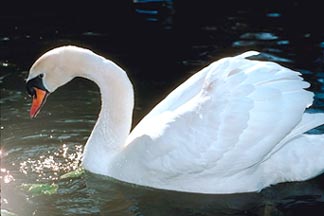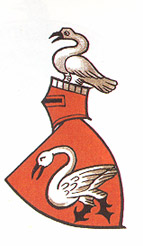

Swans in Heraldry and Lore

In Greek mythology, Zeus took the form of a swan to seduce the beautiful Leda, the wife of Tyndareus, the king of Sparta. The swan was also associated with Aphrodite/Venus, who had a chariot that went through the air pulled by two swans. Native Americans think of the swan as a symbol of trust and summission. The song of a dying swan is thought to be one of the joy of entering the afterlife.
Homer praised the singing swan, which unlike the mute swan can live in more northern climates. The swan was a rarity in Meditteranean regions. Apollo liked the swan and it was revered by northern latitudes.
The swan was said to be present at Apollo's birth and carried him into the sky, and received from him its gift of prophecy. The swan is said to be the enemy of the Eagle...which it has been seen to defeat.
Because of its "swan song" it is thought to be a predictor of impending death and emits extraordinary cries before its own passing. The singing swan of northern Europe (cygnus msicus) can produce a powerful trumpet-like note. If several swans cry at once it is thought to be them singing. In Germanic superstition, a young maiden can wear the plummage of a swan (Nibelungenlied). The swan is known as a symbol of feminine grace. Both Aphrodite and Artemia (Diana) are portrayed in the company of swans. "Swan Lake" is a great Tchaikovsky ballet and is a homage to the feminine side of swan.
In alchemy the swan is associated with the element of mercury, because of its volatility. Swans can be agressive foes when angered. Their wings can literally break the arms of a man. Swans like other birds were used as guards on estates.
In heraldry, the swan is associated with the arms of Boulogne-sur-Mer and the Saxon city of Zwickau, who Latin name was Cygnea. A chivalric Order of the Swan was founded in 1440, then renewed in 1843 by the German King Friedrich Wilhelm II. The order of the Swan was a charitable secular order, but it never came into complete operation. Thus extinct today.
Lohengrin was the swan knight of Wagner's music and German mythology. They were considered the royalty of all waterfowl.
In the Middle Ages the swan was said to be white on the outside with black skin, thus thought to be a symbol of duplicity and hypocrites. A hypocrite when stripped of his white exterior and worldly splendor will go to hell because of his sins. like all the rest.
The swan also symbolized noble purity.


Other Heraldry Links:
Peacocks in Heraldry and Lore
Minnesinger Arms
14th Century Zurich Roll of Arms (peacocks).
Home

This page was last updated on July 31, 2006
